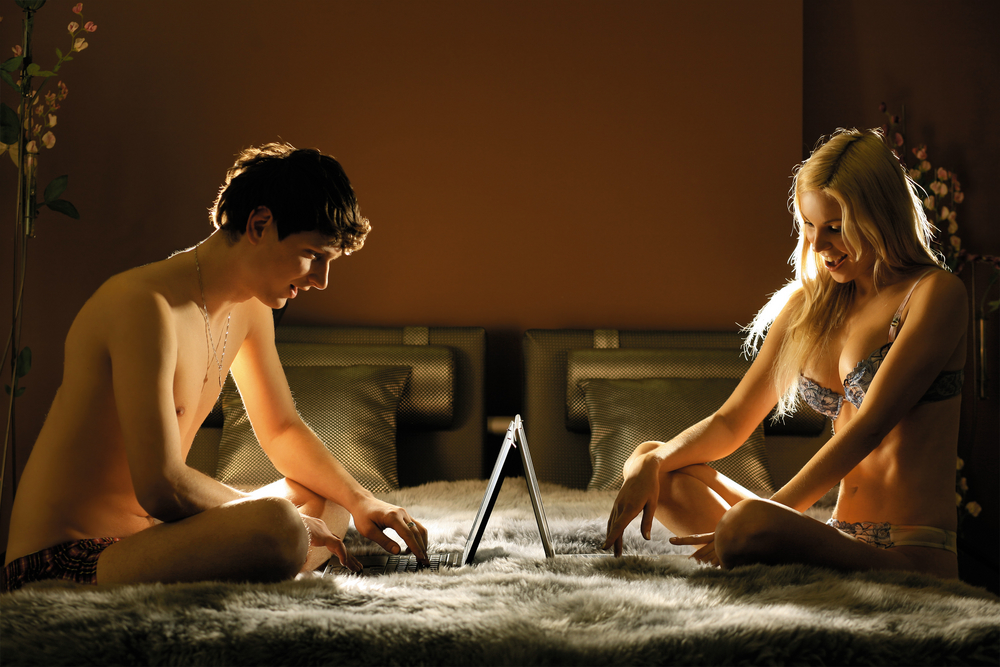The “Triple-A Engine”: How the internet changed porn and how porn changed us

- The internet has changed almost all aspects of our life, but it’s changed porn beyond recognition.
- To unpack the philosophy of porn, Big Think talked with Robert Jensen, emeritus professor at the University of Texas, and Dr. Matthew Ezzell, professor of sociology at James Madison University.
- Jensen and Ezzell argue that porn has changed our wider attitudes to sex and that porn is, in the main, toxic, exploitative, and damaging to most parties involved.
Imagine Simon — an archetypally horny teenager — trying to get his hands on porn throughout the ages. In the ancient world, he wouldn’t find much besides some dodgy graffiti on the walls of the Colosseum and some childish doodles scratched into the cliffside. Sure, rich families might have commissioned a work or two, and holy families might have some bawdy marginalia. But there’s not much.
In the 15th century, the printing press made porn more available but not ubiquitous — it was illegal in most countries and the erotic art you could find was mostly vanilla. The 20th century made things easier for Simon, ushering in readily available magazines and movies. Now, Simon knows where his dad keeps his magazines, and he knows a place across town where they’re loose when checking IDs.
The 21st century now makes the previous one seem prudish. With his smartphone, Simon is on PornHub every day, thumbing through the fetishes and niches of the pornographic web, seeing things even his dad didn’t know were possible — things Simon never really wanted to see.
The internet and pornography go hand in hand. The moment a new app, website, or technology is invented, it’s usually only a few hours before someone somewhere tries to use it for porn. The online porn industry is worth more than Netflix, Hollywood, and Viacom. Just under 6 billion people access Pornhub every month. The internet has changed porn. And, arguably, porn has changed society.
Porn is a huge aspect of everyday people’s lives and so it’s no surprise that it’s the subject of much discussion. It might not be timetabled at your local high school, but philosophy departments all over the world unpack what porn is and what it does. To get a small flavor of these philosophical discussions, Big Think spoke with two philosophers of porn: Robert Jensen, emeritus professor at the University of Texas, and Dr. Matthew Ezzell, professor of sociology at James Madison University.
The sexual norms of pornography
There is a story — albeit an apocryphal one — that the art critic John Ruskin was so repulsed by his wife’s pubic hair on their wedding night that he couldn’t consummate the marriage. Ruskin’s knowledge of the female body had been entirely defined by classical statues and paintings, so when it came to seeing an actual naked woman, he was shocked.
The Ruskin myth is so enduring because it highlights the fact that we all have to be educated about sex somehow. Our parents might hold an awkward “birds and the bees” conversation. Or our schools may have a sex-ed class, though these are usually a sanitized, textbook version of sex that hides behind euphemisms and prudishly self-censors. Other times, people learn about sex from their peers — in giggling whispers or with bragging or strutting exaggeration. In reality, most people actually learn about sex by having sex.
The internet changed that. Now, almost anyone with an unlocked smartphone can access millions of videos about sex. Of course, the primary intention is an erotic one, but the secondary and unconscious one is pedagogical. A porn video is arousing, but it’s also educational. It’s telling the virginal and inexperienced that this is what sex is like. This is what proper sex is like.
As Ezzell puts it: “Media matter. They are a powerful force for learning and for the delivery of hegemonic ideologies. Sexualized media are arguably particularly powerful as agents of socialization and enculturation because they are so often consumed to facilitate masturbation. Social learning theory argues that media can provide heuristic scripts that help guide meaning-making and decision-making. That process is made stronger in the absence of compelling alternative scripts. In short, pornography will rush to fill the void, becoming the primary form of sex education for young people.”
The Triple-A engine of porn
Before the 1990s, porn was available, but it usually had gatekeepers and was far more limited. The porn of the 2000s differed in three important ways — what some researchers call “the Three As” of anonymity, accessibility, and affordability. It’s easy and free to watch porn, and no one will know you’re doing so. As Jensen explains:
“There is the triple-A engine of the internet. First, anonymity. You can go online and you can view not only sexually explicit material but this very hard-core degrading material without ever revealing yourself in public. You don’t have to go to a movie theater. You don’t have to go to a magazine store. Second, affordability. It’s increasingly cheap, and a lot of young people never bother paying for pornography online. There are so many free options.
And then, accessibility. Anyone can get to it, including increasingly young children. I often reflect that I was born in 1958, when I was 14 years old, and young boys wanted to find pornography. It was very difficult. You had to, you know, figure out where your father hid it in his drawer. You know, we used to go into the one pornographic movie theater in town that had a faulty exit door that we could get in through. Now, those days are gone. Because, of course, any 10-year-old can get online and access it.”
How porn has changed us
Today, anyone can access porn, and billions do. So what effect is that having on society? Jensen points out two ways internet porn has changed us. One is that young men are experiencing difficulties having sex, seemingly for no physiological reason. Jensen says:
“[I spoke with] a lot of younger men who were physically healthy and had no physiological problems that would lead to erectile dysfunction who were reporting difficulty being intimate in real life with a female partner. And so the term ‘porn-induced erectile dysfunction’ has now emerged… I had men tell me, and this is going back decades now, ‘I can’t even get an erection without thinking about porn.’ So the first step of [internet porn addiction] was men reporting that their real-life sexual interactions required a kind of pornographic jump start. It got to the point where some were saying, ‘I can’t perform sexually in real life with a partner because my sexuality has been so conditioned to this porn and the intensity of pornography stimulation.’”
Second, on sexual norms. Jensen talks about the rabbit hole effect of online porn. Most people start out watching what we’d call standard, vanilla sex. But then they’d click on another video or get excited about a certain fetishistic element. They’d click on another video, this time more intense.
“People would use the term ‘normal sex’,” Jensen says. ”But then I would stumble upon a clip that was a little more intense, a little more degrading, a little more kinky. Whatever term they would use. And then I kind of got a taste for it.” The result is that this kind of kinky, degrading, and cruel sex has become normalized. It can be used to define what sex should be. This “very aggressive, rough, violent form of sexuality” bubbles up into the everyday dating scene. Jensen mentions that “one example of this very clearly is where there’s an increase in strangulation during sex.”
Jensen gives another example:
“I was at the book fair in New York, and, you know, hyping my book and sitting there at the booth, and this woman came up, and she was a freelance journalist. She said, ‘You know, I was married for a long time. I recently got divorced, and I went back into the dating pool in New York City. The first thing I noticed was how routinely men requested anal intercourse. I don’t remember that when I was younger.’ And part of the book was explaining the rise of that particular sexual practice in porn.”
The vicious circle of the porn industry
As porn has grown on the internet, its “triple A engine” has been locked in a kind of vicious circle with consumers. Porn becomes more violent, which means users seek out more violent porn for simulation, like some addicts who need to increase the dosage to keep getting the same hit. The result — where we are now — is a sizable subculture of young men who can’t have sex without being or thinking of sexually violent acts and establishing degrading, cruel sex as “normal.”
Of course, increasingly aggressive and intense sexual acts will affect not only those who watch porn but also those who make it. Here, Jensen shares a shocking anecdote:
“I used to do research in part by going to the porn industry conventions, and I would always ask the directors, the producers, you know, what are some of your major challenges? And this was in the 2000s, and a number of them said, ‘Well, you know, in the old days, you could shoot a girl and then call her three months later and use her in another scene. It was kind of a stable industry with well-known performers. Now it’s hard because this is an industry that chews up and spits out women at a pretty alarming rate. I’ll use someone in a scene, and a month later she’ll be gone.’ And the reason for that was the expectations for sexual performances were intensifying.”
The Only Fans generation
And where are all these would-be porn stars going? What other avenues are there if you want to join the industry? Well, in the past five years — mainly emerging from the COVID lockdown years — there’s been a new phenomenon: OnlyFans. OnlyFans allows users to pay for access to videos they make. It could be for fitness videos, cooking tutorials, or self-help advice. Mostly, though, it’s used for creating porn. This peer-to-peer, tailor-made porn is seen as a threat to the porn industry but has also been labeled “empowering” by some commentators and users.
Jensen disagrees. “Well, the first thing on the term ‘empowering.’ If you’re meeting with your high school guidance counselor or, you know, your college advisor, if pornography is so empowering, what are people saying to women who have other options? Do they say, ‘You know, don’t forget, you should consider a career on OnlyFans?’ No, any woman who has other options to make a living will almost certainly take those options.”
For Jensen, OnlyFans is not some silver bullet that brings sex work mainstream and upends all of the misogynistic, degrading, aggressive norms that porn has established for decades. It still works for men. As he put it, “We also have to realize that where there is a sex industry—or, as I call it, the ‘sexual exploitation industry,’ — there are pimps. And sometimes those pimps are not readily visible, but the presence of primarily men who run the sexual exploitation industries and profit from women’s participation is true in OnlyFans, as it was true in porn, as it’s true in street prostitution, and in every other form of sexual exploitation.”
The acceptable unacceptable
For Jensen, the porn industry has always “sexualized every domination subordination-dynamic you can think of,” but the internet was the “engine.” Once, porn was a hidden and restricted business (albeit still exploitative). Now, it’s so common as to reorientate many people’s perceptions of other people, sexually or not.
This is how Ezzell explains it:
“Research on pornography exposure and attitudes and beliefs shows us that pornography exposure often precedes sexist beliefs and ideologies, and that sexist beliefs and ideologies then fuel the drive to consume more pornography. In other words, the industry tends to shape desires and beliefs, and those desires and beliefs continue to push the industry in those same directions. Sexual practices and patterns never happen in a vacuum. When we see increases in “rough sex” and injury, we have to ask, “Where does this come from? Where are people learning to do these things or to view these things as sexual or pleasurable?” I think it’s hard to argue that pornography plays no role.”
There have always been poisonous elements in our collective unconscious. There’s been misogyny, racism, sexism, violence, and abuse. For Jensen and Ezzell, the internet has added an arterial energy to this poison. Internet fans can see the flames of these toxic dynamics that have flickered as embers for millennia. While we publicly rage against normalizing exploitation in almost all walks of life, six billion people are going home to log on to PornHub to enjoy it.





